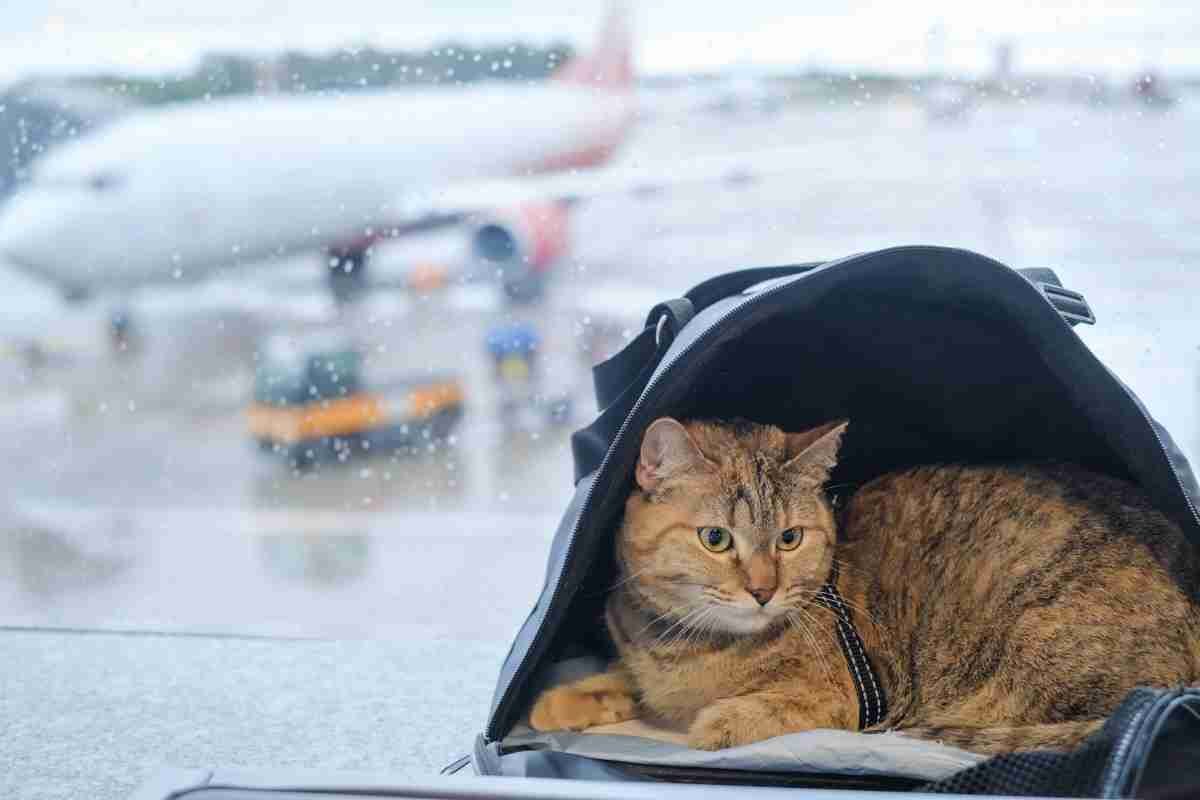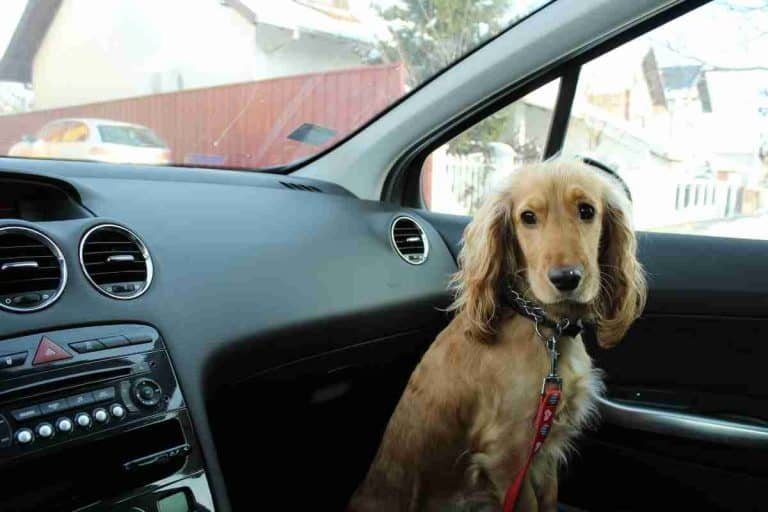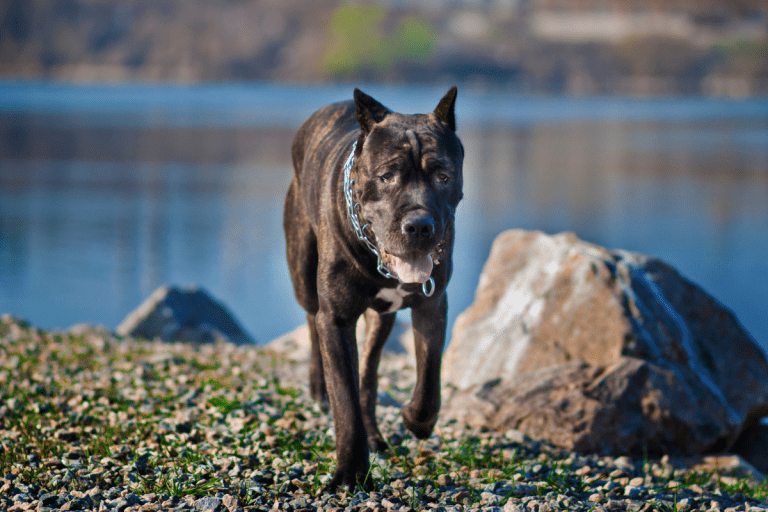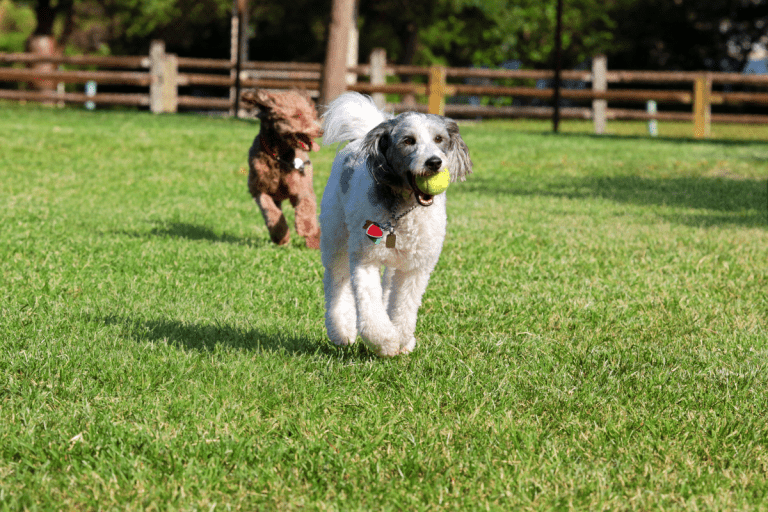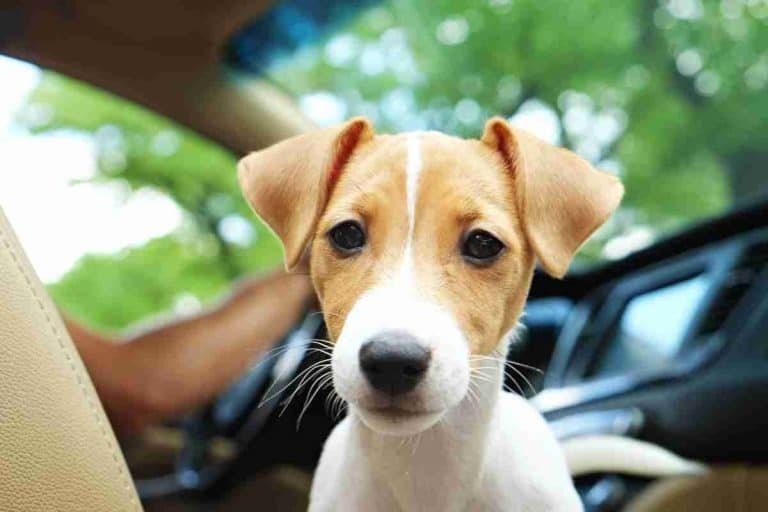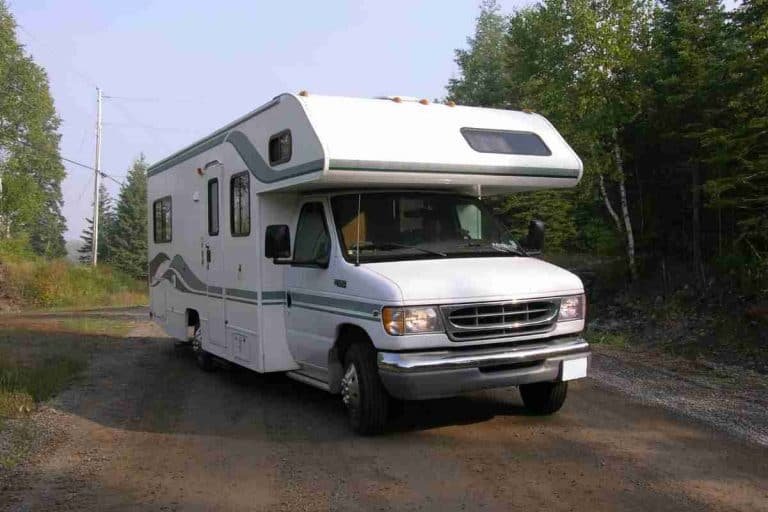10 Airlines That Allow Cats in the Cabin — Policies, Fees & How to Prepare
Last Updated on September 5, 2025
Many travelers need airlines that allow cats in the cabin. 10 Airlines That Allow Cats in the Cabin — Policies, Fees & How to Prepare compares rules, fees, and prep steps. Policies differ by carrier: under‑seat carrier dimensions, pet limits, health certificates, and breed or route restrictions. Reserve early to lock a pet spot, reduce avoidable fees, and prevent last‑minute denials.
The post offers a quick airline reference and practical planning guidance. It outlines carrier size ranges, typical pet fees, and reservation steps. It explains refund caveats, TSA screening, and day‑of‑travel tips. It also covers microchipping, rabies vaccination records, international rabies titers, and calming techniques. Owners can choose a compliant soft‑sided carrier, organize documents, and keep cats comfortable throughout the flight.
Quick reference — the 10 airlines that accept cats in-cabin
Most major U.S. carriers permit cats in the cabin when they ride inside an approved carrier stowed under the seat. Rules vary on carrier size, number of pets per flight, destination paperwork, and breed restrictions. Pet fees typically appear per flight and commonly fall within a broad range. Always reserve a spot for the cat in advance and confirm requirements for the specific route.
- American Airlines
- Delta Air Lines
- United Airlines
- Alaska Airlines
- JetBlue
- Southwest Airlines
- Frontier
- Spirit Airlines
- Hawaiian Airlines
- Breeze Airways
Airline 1 — American Airlines (summary: in-cabin rules & pet fee)
American Airlines accepts cats in the cabin on most domestic flights when carriers fit under the seat. Passengers typically may bring one pet carrier per person, and airlines enforce size limits rather than weight alone. Reservations for in-cabin pets often close when the pet allotment fills, so book early. Fees vary by route, and owners should confirm current charges and any health certificate requirements with American before travel. For guidance on selecting carriers that fit under seats see dog breeds that fit under airplane seat.
Airline 2 — Delta Air Lines (summary: in-cabin rules & pet fee)
Delta allows cats in-cabin on most flights with an approved carrier that stows beneath the seat in front. The carrier counts as the passenger’s carry-on allowance. Delta may require advance notice and limits the total number of pets per flight. Fees apply per segment and vary by itinerary. Owners should verify any breed or destination restrictions before booking. For context on which animals typically travel in-cabin see dogs you can take on a plane.
Airline 3 — United Airlines (summary: in-cabin rules & pet fee)
United permits cats in the cabin when they ride in approved soft- or hard-sided carriers that fit under the seat. United enforces carrier dimensions and charges a pet fee per flight segment. International trips carry additional rules and paperwork. United sometimes limits the number of in-cabin pets on specific aircraft. Travelers with more than one cat should plan logistics carefully; guidance for traveling with multiple felines appears in flying with two cats on a plane.
Airline 4 — Alaska Airlines (summary: in-cabin rules & pet fee)
Alaska Airlines accepts cats in-cabin if carriers comply with under-seat size limits and remain closed for the flight. Some routes impose seasonal or aircraft-specific limits. Alaska typically charges a per-flight pet fee and asks passengers to call to reserve a pet spot. Owners should secure the carrier and minimize in-cabin movement; practical tips for stabilizing and securing a carrier are available in how to secure a cat carrier in car.
Airline 5 — JetBlue (summary: in-cabin rules & pet fee)
JetBlue welcomes cats in-cabin on many flights when passengers use approved carriers that stow under the seat. The airline enforces a pet limit per cabin and requires advance reservation for animals. Fees are charged per direction and can vary by market. JetBlue also provides travel guidance for stressed pets; owners who travel with nervous cats should review tips on how to travel with a fussy feline.
Airline 6 — Southwest Airlines (summary: in-cabin rules & pet fee)
Southwest allows cats inside the cabin on most flights when the carrier fits fully under the seat. The carrier must stay closed and stowed during taxi, takeoff, and landing. Southwest enforces a limited number of in-cabin pets per flight and charges a pet fee per direction. To reduce the chance of vocal stress or complaints, review behavioral tips for noisy cats on planes before flying; see 8 tips to stop a loud cat on a plane.
Airline 7 — Frontier (summary: in-cabin rules & pet fee)
Frontier permits cats in the cabin with approved carriers that remain under the seat. The carrier size, pet temperament, and aircraft type can affect approval. Frontier charges a fee per animal and limits the count per flight, so advance booking is essential. Plan for in-flight care, including elimination options during long segments; practical tips about feline bathroom needs during flights are at how do cats go to the bathroom on plane.
Airline 8 — Spirit Airlines (summary: in-cabin rules & pet fee)
Spirit accepts cats in-cabin on many routes but enforces strict capacity and size rules for carriers. Fees apply per flight and can be nonrefundable. Spirit travelers should notify the airline when booking and arrive early at the gate to confirm the pet reservation. Managing barking or vocal reactions by other animals in the cabin helps avoid problems; see guidance on in-flight barking and reactions at what happens if my dog barks on a plane.
Airline 9 — Hawaiian Airlines (summary: in-cabin rules & pet fee)
Hawaiian allows cats in-cabin on some flights, with strict paperwork for flights to or from Hawaii. Inter-island travel often has simpler requirements, while flights crossing state or international lines may need health certificates and advance approvals. Fees vary by segment. For longer flights, owners should consider ear-pressure comfort and acclimation techniques; general in-flight ear considerations appear in does flying hurt dogs ears.
Airline 10 — Breeze Airways (summary: in-cabin rules & pet fee)
Breeze permits cats in-cabin with approved carriers that remain stowed under the seat. The airline caps the number of pets per flight and requires a reservation for animals. Fees apply per each direction. Owners should use calming strategies and pre-trip conditioning to reduce stress during boarding and taxi. Practical calming tips for car transport often translate to air travel; see how to calm down a cat in the car.
Common cabin-pet rules every owner must know
Airlines share similar baseline rules for cats traveling in the cabin. Owners must reserve a spot in advance, pay the in-cabin pet fee, and present up-to-date vaccinations and identification at check-in. Most carriers require pets to remain inside an approved carrier for the entire flight, with the carrier stowed under the seat during takeoff and landing. Airlines limit the number of pets per flight and can deny boarding if the cabin reaches capacity. Temperature and health restrictions sometimes apply on extreme-weather days. Sedation is generally discouraged and may void carrier acceptance. At international checkpoints, additional health certificates or import permits can be mandatory, so owners should verify destination rules well before departure. Arrive early to allow staff to verify paperwork and to acclimate the cat to the carrier and gate area. For guidance on calming a nervous cat and practical travel prep, see how to travel with a fussy feline. Owners should always confirm current airline policy before purchasing tickets to avoid surprises.
Carrier size, weight and under-seat placement requirements
Airlines set strict carrier size and weight limits to ensure a safe fit under the seat. Common maximums accept carriers roughly 18 x 11 x 11 inches, but dimensions vary by aircraft and seat pitch. Soft-sided carriers compress slightly to fit; hard crates rarely qualify for under-seat use. Carriers must provide ventilation on multiple sides, a secure closure, and a leak-proof bottom. Many carriers allow pets and carrier to weigh up to 15–20 pounds combined, though some airlines set lower limits. Measure the cat from nose to tail base and from floor to shoulder to confirm a comfortable fit. Label the carrier with contact details and bring a familiar blanket or shirt to reduce stress. Gate agents may request carrier inspection before boarding, and attendants may ask owners to briefly remove the carrier from the under-seat space during boarding. For tips on stabilizing and securing a carrier in vehicles, consult how to secure a cat carrier in car.
Limits per passenger and allowance for multiple pets in one carrier
Most airlines allow one pet per passenger in the cabin. Some carriers permit two small pets in a single carrier if the animals fit comfortably and local rules allow. Two separate carriers typically count as two animals and require two paid reservations. Families traveling with multiple pets should check whether the airline restricts the total number of animals per flight or per row. For connecting itineraries, each segment must honor the same pet allowance. The fee structure usually charges per pet, though a few airlines offer reduced rates for second pets in the same carrier. Reservations for pets often sell out, so book early and reconfirm with the carrier before departure. When flying with two cats in one carrier, owners should ensure both animals share a calm temperament and sufficient space. Practical advice for transporting two felines together appears in flying with two cats on a plane.
Breed, species and age restrictions (including snub-nosed breeds)
Airlines list breed and species restrictions to reduce health risks. Brachycephalic (snub-nosed) breeds face tighter rules because of breathing vulnerabilities at high altitude and stress. While most guidance centers on dogs, several carriers apply similar caution to cats with flat faces. Some airlines bar certain breeds or require a fitness-for-travel letter from a veterinarian. Species rules vary: many airlines allow cats and small domestic animals like rabbits, while exotic species may need special permits or face outright bans. Age minimums commonly require animals to be at least eight to 12 weeks old, fully weaned, and current on core vaccinations. Pregnant animals may be refused for travel. Always verify breed- or species-specific restrictions on the carrier’s policy page before booking. For carrier eligibility related to snub-nosed animals, consult airline-specific listings such as airlines that allow snub-nosed dogs, which illustrate common limitations.
Airline policies on emotional support and service animals vs pets
Airlines now treat emotional support animals differently from trained service animals. Most U.S. and international carriers categorize emotional support animals as pets. That classification subjects them to carrier, fee, and vaccination rules. Trained service animals, typically dogs, receive broader access under disability laws but still face airline documentation and behavior requirements. Airlines may require advance notice for service animals and specific forms demonstrating training or need. When travel involves a support animal, airlines often request recent veterinary records and behavioral attestations. Misrepresenting a pet as a service animal risks denial of boarding and fines. Crews will intervene if an animal becomes disruptive, aggressive, or unsanitary during flight; behavioral expectations apply equally to service animals and pets. For context on in-flight behavior and crew responses, see what happens if a dog barks on a plane. Owners should contact their airline early to confirm the correct classification and required paperwork.
How much it typically costs and how to reserve a pet spot
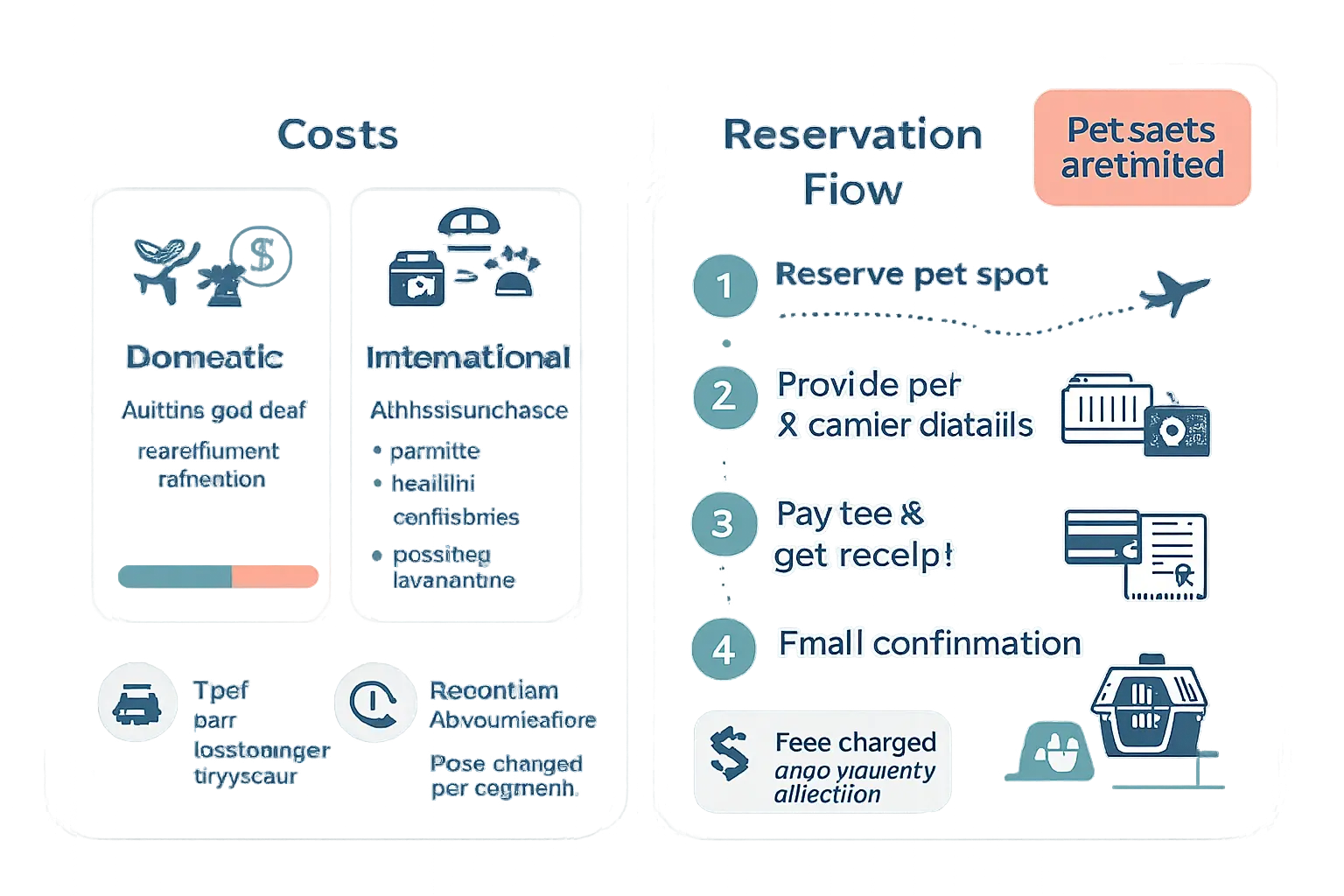
Travelers should expect two separate costs: the airline pet fee and any destination-related charges such as import permits or quarantine. Domestic in-cabin fees typically fall into a range that reflects seat availability and airline policy. International travel adds paperwork and possible third-party charges for veterinary certificates or customs clearance.
Most airlines limit one pet per passenger and require the carrier to fit under the forward seat. Because cabin space is limited, the pet reservation is often handled differently than a regular seat. To avoid surprises, confirm limits and fee rules before booking.
For a practical look at what airlines accept and how pet size affects travel, see Dogs you can take on a plane. That resource helps compare size and carrier requirements across carriers.
Reserve early. Pet spots often fill before the flight sells out. If the airline allows online pet bookings, secure the spot during ticket purchase. Otherwise call the carrier and ask for a pet reservation code. Keep all confirmations and note any special instructions on the booking record.
Typical fee ranges (domestic vs international) and when fees vary
Domestic in-cabin fees usually range from modest to moderate. Expect common ranges rather than fixed prices, because each airline sets its own rules. For many carriers, typical domestic in-cabin fees fall between low-range service charges and one-time pet fares.
International travel raises costs in two ways: higher airline surcharges and mandatory paperwork fees. Import permits, health certificates, and quarantine can add several hundred dollars. Some countries require advance reservation of an arrival inspection, which also carries a price.
Fees vary by weight, carrier dimensions, and whether the pet travels as a carry-on or checked animal. Seasonal demand, route length, and whether the animal occupies a seat also affect pricing. Loyalty status and military or service exemptions can reduce or waive fees in some cases. Always ask the airline what specifically the fee covers, and request a written breakdown before payment.
Booking steps: reserving a spot, seat assignment and confirmations
Follow a clear sequence when booking to avoid denied boarding at the gate. First, read the airline’s pet-in-cabin policy for carrier size, weight limits, and breed restrictions. Second, check seat maps for forward-seat availability; some airlines block certain rows for pets.
- Contact the airline if the online checkout lacks a pet option. Request a pet reservation number and add it to the booking.
- Provide required pet details: species, breed, age, weight, and carrier dimensions. Some carriers ask for a photo of the carrier.
- Pay the pet fee and obtain a receipt. Confirm seat assignment that accommodates the carrier under the seat.
- Request written confirmation via email. Confirm the pet reservation again 24–48 hours before departure.
For travelers managing multiple cats, practical tips and stepwise guidance appear in Flying with two cats on a plane. That post clarifies logistics for double-pet bookings.
CTA: Call the airline to lock the pet spot at booking and reconfirm before travel.
Cancellation, change fees and refund rules for pet bookings
Airlines treat pet reservations like ancillary services. Cancellation and change rules often differ from standard ticket policies. Some carriers allow free changes to the flight but still charge a new pet fee if availability changes. Others refund the pet fee only if the airline cancels the flight or cannot accommodate the animal.
Refund policies depend on timing and the reason for cancellation. If a passenger cancels, many airlines keep the pet fee as a service charge. If the airline cancels or rebooks you onto a flight that cannot accept pets, expect a full refund for the pet fee and assistance rebooking. Documentation helps. Keep receipts, written confirmations, and any communications proving the airline denied pet travel.
When changes are possible, act quickly. Rebooking early improves the chance of an available pet-approved seat. Consider refundable fares or travel insurance that covers pet-related disruptions.
Paperwork, vaccines and health requirements to travel with cats
When preparing to fly, travelers should consult the guidance in 10 Airlines That Allow Cats in the Cabin — Policies, Fees & How to Prepare and each airline’s pet policy. Airlines commonly require a recent veterinary health certificate, proof of rabies vaccination, and a carrier that fits under the seat. Requirements vary by carrier, route and destination, so the owner must confirm timelines and fees directly with the airline.
Keep original documents and electronic copies accessible during check-in. Many carriers limit pets per flight and enforce specific carrier dimensions. Reserving a pet spot early reduces surprises at the gate. For international trips, allow extra lead time for tests and permits.
CTA: Contact the airline at least four weeks before travel to verify all paperwork and fees.
Standard documents: health certificates, rabies vaccination records
Most airlines require a veterinary health certificate issued within a short window before travel. Typical domestic windows range from 7 to 10 days, though exact timing varies by carrier. The certificate must state the cat is fit to fly and free of contagious disease. The veterinarian should sign and date the certificate and include the clinic’s contact details.
Proof of rabies vaccination is essential for many routes. The record should include the vaccine manufacturer, lot number, date of administration and expiration. If the cat is too young for rabies at the time of travel, airlines or destination authorities may deny boarding.
Owners should keep a printed copy of all vaccine records and the health certificate in the cat’s carrier. Also keep electronic copies on a phone or cloud storage. For practical tips on bringing cats through airport procedures and space management, see flying with two cats on a plane.
International rules: rabies titers, quarantine and country-specific forms
International travel often adds layers of regulation. Many countries require a rabies titer test (FAVN) to confirm the cat developed sufficient antibodies. The titer usually must be drawn at least a certain number of days after vaccination and often months before entry. Some destinations also require an import permit or a government-issued health endorsement.
Customs and agricultural authorities may impose quarantine periods. Quarantine rules depend on the destination and the cat’s origin country. Countries that are rabies-free frequently enforce stricter entry paperwork and longer lead times.
Owners should consult the destination country’s embassy or veterinary authority well in advance. Official sources will list required forms, approved labs for titers, and any mandatory waiting periods. For general travel tips that help reduce stress during complex journeys, refer to how to travel with a fussy feline.
Microchipping and ID recommendations
Microchipping provides permanent identification and often proves mandatory for international travel. Many countries require an ISO-compliant microchip or a chip readable by an ISO scanner. If a different chip is implanted, the owner should carry a compatible reader or have the chip number recorded on all paperwork.
Register the microchip with up-to-date contact details and emergency contacts. Add the chip number to the cat’s health certificate and vaccination records. Collar identification with a secure breakaway tag can speed reunion if the cat escapes during transit.
Maintain both paper and digital copies of registration, vaccination records and the microchip number. Seal a copy in the carrier and place copies in checked baggage or a carry-on. For practical carrier and restraint tips that pair with ID best practices, see how to secure a cat carrier in car.
Choosing and packing the right in-cabin carrier
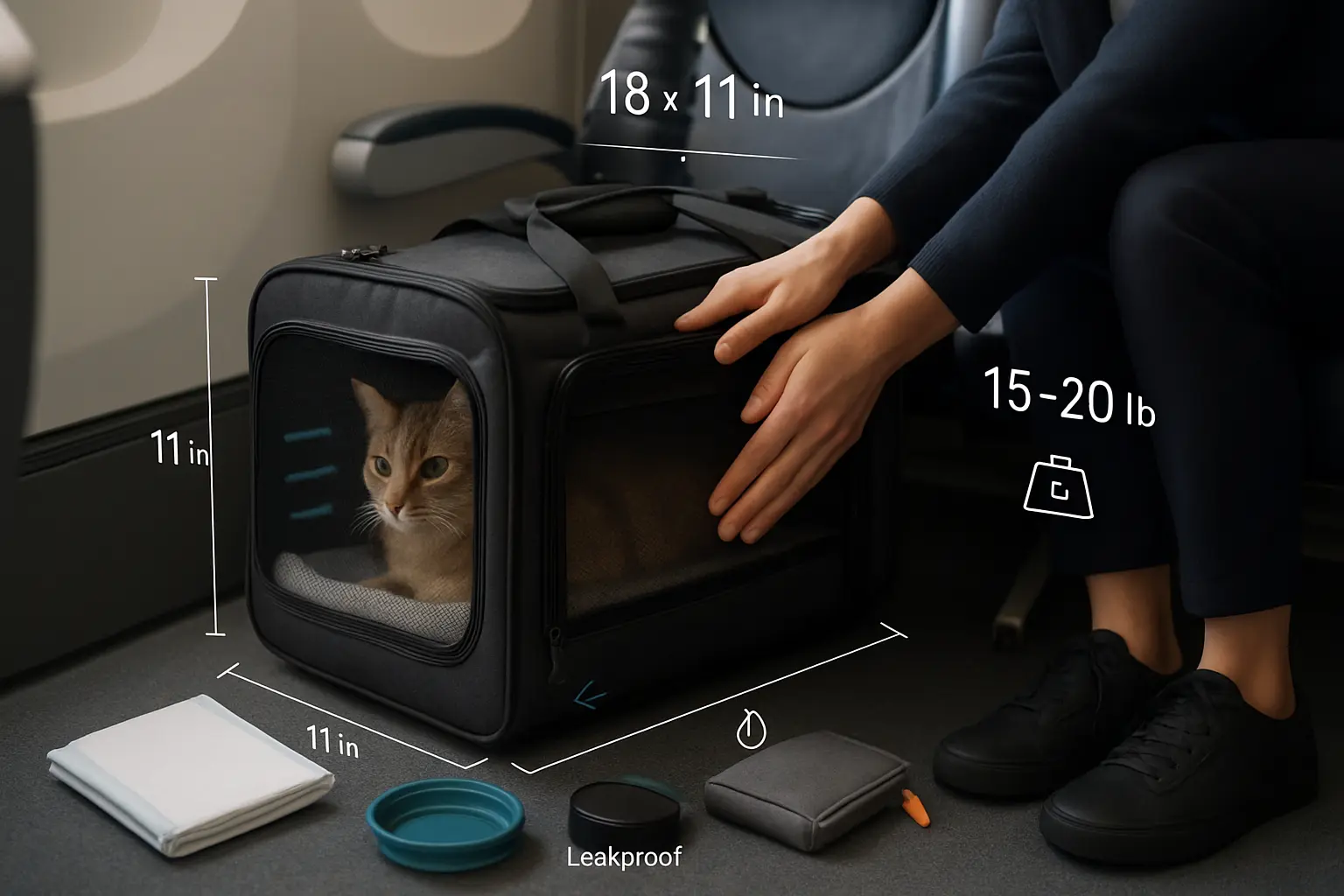
Choosing the correct in-cabin carrier affects comfort, compliance and safety. Owners should pick a carrier that meets the airline’s dimensions, feels stable on the floor, and gives the cat room to turn and lie down. A snug but not cramped fit reduces stress and helps the pet stay calm during taxi, takeoff and landing. Pack efficiently so the carrier stays light and easy to slide under the seat.
Confirm the airline’s carrier rules and any pet fee at booking to avoid surprises.
Airline-approved carrier dimensions and soft vs hard-sided carriers
Airlines publish maximum carrier dimensions for under-seat storage. Soft-sided carriers compress slightly, which helps them fit irregular under-seat spaces. Hard-sided carriers keep shape and protect against bumps, but they rarely compress enough to meet tight airline limits. Choose soft-sided if the airline permits it and the cat accepts the material. For larger short-haul aircraft with deeper footwells, a low-profile hard carrier can work.
Measure the carrier when empty and again with the cat inside, if possible. Always compare those measurements to the airline’s published limits before purchase.
Ventilation, leakproofing and under-seat fit checks
Good airflow prevents overheating. Look for carriers with mesh panels on multiple sides and secure closures. A leakproof base prevents accidents from soaking bedding. Before travel, test the carrier under a seat or a low table to confirm clearance. Practice zipping and unzipping with the cat inside to ensure quick access. For tips on stabilizing and securing a carrier in confined vehicle spaces, see how to secure a cat carrier in car.
What to pack inside: bedding, absorbents, treats and calming aids
Line the carrier with a thin, familiar-smelling blanket to comfort the cat. Add a single absorbent pad to handle accidents without bulk. Include one small food-safe treat and a collapsible water dish for long waits. Avoid bulky toys that block ventilation. Consider a pheromone spray or a veterinarian-recommended calming aid used at home first. Label the carrier with the cat’s name, owner’s contact, and flight details.
CTA: Verify carrier size with the airline and reserve the pet spot when booking to secure compliance and peace of mind.
Preparing your cat before travel
Preparing a cat before a flight focuses on gradual exposure, predictable routines, and paperwork. Start by confirming airline rules and reserving a spot for the carrier. Practice short car trips and in-home desensitization to reduce novelty and motion stress. Maintain the cat’s regular feeding and sleeping schedule when possible to avoid extra anxiety.
Gather documentation early: vaccination records, a recent health certificate when required, and any microchip information. Secure identification on the carrier and a collar with contact details. Assemble a compact travel kit with a towel, a familiar-smelling blanket, a small litter box if allowed, and absorbent pads.
Monitor the cat’s temperament during practice trips and adjust plans if signs of severe stress appear. For behavioral strategies to calm travel-reactive cats, consult resources such as how to calm down a cat in the car. Book flights during quieter times, choose non-stop routes when possible, and arrive early to reduce rushed handling. CTA: confirm the carrier size and cabin fee with the airline at booking to avoid last-minute surprises.
Carrier acclimation and short practice trips
Carrier acclimation prevents panic during check-in and under the seat. Begin two to four weeks before travel. Leave an open carrier in living areas so the cat can explore freely. Add soft bedding and a worn T-shirt to build a positive scent association.
Introduce short, frequent practice trips. Start with five- to ten-minute walks in the carrier, then progress to 30‑minute car rides. Reward calm behavior with treats and soft praise. Use gradual increases to build tolerance for movement and confinement.
Make the carrier comfortable and compliant with airline rules: measure the cat’s length and height, verify under-seat dimensions, and choose a well-ventilated, soft-sided carrier when the airline allows it. For practical tips on securing carriers in vehicles, see how to secure a cat carrier in car. Avoid forcing the cat in; use a towel or gentle coaxing to reduce fear. Complete at least three full-length trial runs, including a mock “airport” routine with crate placement, loading, and brief handling.
Feeding, hydration and exercise timing before departure
Timing food, water and activity reduces bathroom incidents and motion sickness. Feed the cat a smaller-than-usual meal about four to six hours before departure. This timing lowers the chance of nausea while leaving enough time for digestion.
Offer water up to two hours before travel, then limit access to prevent accidents. For long flights or layovers, plan scheduled water breaks when safe. Encourage a vigorous play session two to three hours before leaving. Exercise helps expend energy and encourages a restful nap before the flight.
If the flight involves long waits, line the carrier with absorbent pads and a small, familiar-smelling towel. Prepare for in-flight elimination questions by reviewing resources such as how do cats go to the bathroom on plane. Adjust meal and water timing for the cat’s known sensitivities. Keep treats on hand to reward calm behavior during boarding and takeoff.
Medication, sedation guidance and discussing options with your vet
Medication and sedation decisions require a veterinarian’s assessment. Many vets avoid full sedation for air travel because it can depress breathing and affect temperature regulation. Instead, they recommend behavior modification and short-acting anxiolytics in specific cases.
Schedule a pre-travel exam at least two weeks before departure. Discuss the cat’s health, airway stability, and any underlying conditions. If medication is appropriate, obtain a trial dose before travel to observe effects in a controlled setting. Never give human medications without veterinary approval.
Explore non-pharmaceutical options: pheromone sprays, calming wraps, and trained desensitization. For strategies to handle fussy felines, review guidance at how to travel with a fussy feline. Document all prescriptions and dosing instructions, and carry them in the carry-on. Coordinate with the airline if special handling or documentation is necessary for administered medications.
Day‑of‑travel procedures and airport tips
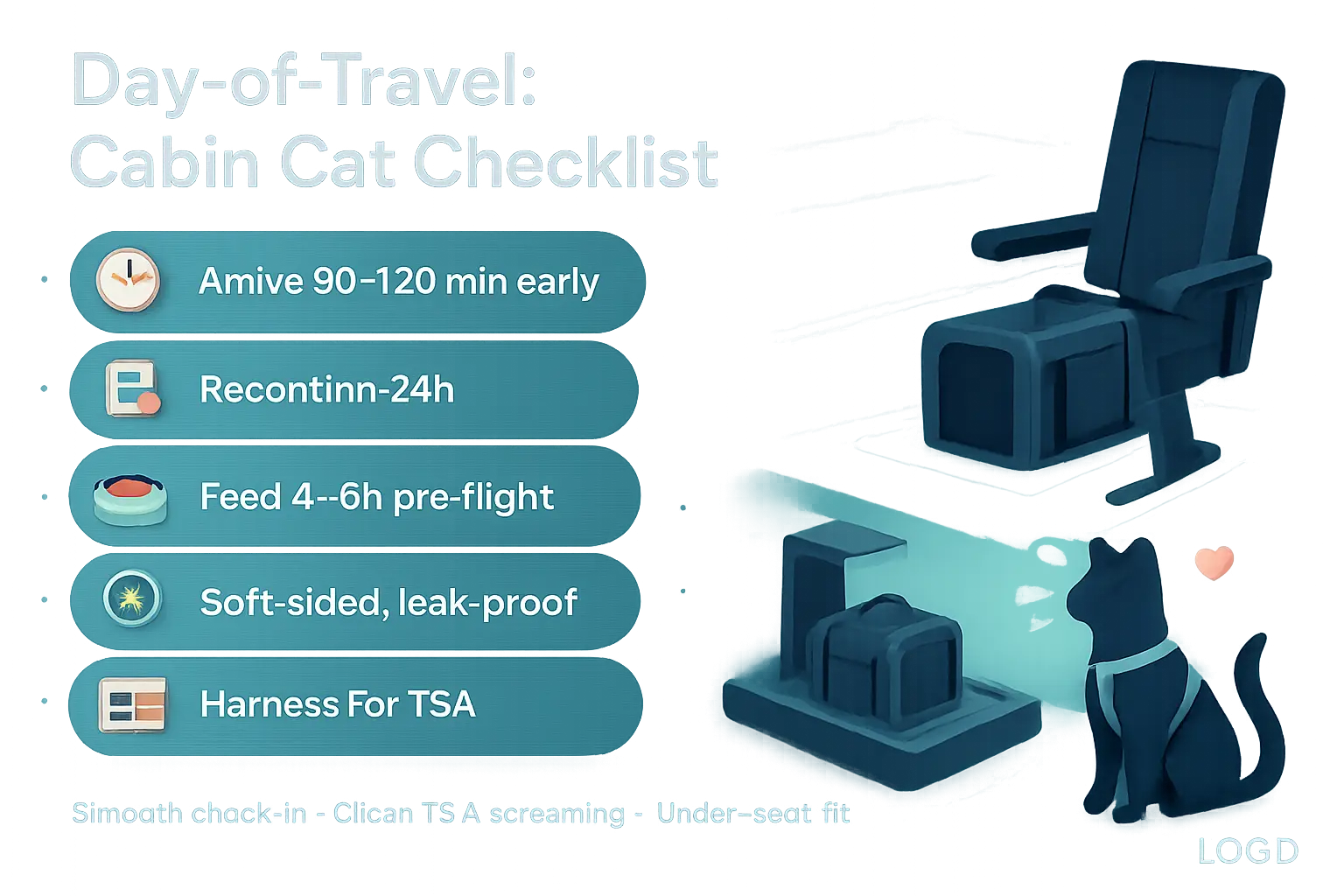
On travel day, start early and confirm the airline’s pet policy and fee at check‑in. Arrive at the airport with time to spare—most carriers recommend 90 to 120 minutes for domestic flights with pets. Keep the cat in its carrier until instructed otherwise and carry proof of vaccinations and any required health certificate in an accessible folder.
At the gate, staff will verify carrier dimensions and that the cat remains inside. Use a soft‑sided carrier that fits under the seat and has a leak‑proof pad. Place a familiar blanket or pheromone‑treated cloth inside to reduce anxiety. Offer a light feeding four to six hours before departure to avoid motion sickness.
Travelers who want more practical prep can review procedures for in‑flight feline needs, such as bathroom planning and timing, at how do cats go to the bathroom on a plane. Confirm pet spots and fees by phone the morning of departure to avoid surprises. CTA: call the airline 24 hours before departure to reconfirm the reservation and any last‑minute requirements.
Security screening process for cats and carriers
At TSA checkpoints, cats must exit the carrier for screening unless the owner requests a physical inspection. Place the carrier on the X‑ray belt; hold the cat securely in arms or on a leash while their paws stay low to lower stress. Use a harness rather than a collar during screening to reduce escape risk.
Staff should alert the owner before handling the cat. Keep the carrier door closed with a light clip so security staff can open it for inspection without the cat escaping. If the cat resists being removed, request a private screening area. Carry a small towel to wrap the cat temporarily, which can calm and prevent scratching.
For tips on safely handling and securing carriers outside the airport, see how to secure a cat carrier in car. Prepare paperwork, have carriers cleaned and free of loose debris, and practice carrier exits at home so the cat tolerates the brief removal required at security.
Handling layovers, gate checks and boarding etiquette
During layovers, maintain the cat inside the carrier and avoid crowded waiting areas. If time allows, find a quiet corner for brief calm breaks without opening the carrier. For long layovers, ask airline staff about pet relief areas; not all airports provide them, so plan accordingly.
Gate checks occur when the cabin lacks space under seats. If staff request a gate check, ensure the carrier meets the airline’s gate‑check requirements and attach identification tags. Retain valuables and medical records with the owner, not inside a gate‑checked carrier.
Boarding etiquette: board when the airline calls pets, secure the carrier under the seat in front, and ensure airflow for the cat. For strategies when traveling with multiple cats or transferring flights, consult guidance on coordinating carriers and connections at flying with two cats on a plane. Speak calmly with nearby passengers and keep interactions minimal to reduce your cat’s stimulation.
Managing stress during the flight: signs, calming techniques and emergencies
Cats show stress through panting, excessive meowing, drooling, pacing inside the carrier, or hiding. Owners should watch these signs and intervene early. Keep a small kit with a blanket, absorbent pad, collapsible water dish, and a few treats for reassurance.
Calming techniques include placing a familiar‑scented cloth in the carrier and using synthetic feline pheromone sprays about 15 minutes before travel. Gentle verbal reassurance and firm but soft handling reduce panic. Avoid sedatives unless a veterinarian prescribes them; sedation can depress respiration at altitude.
For noisy or vocal cats, practical tips help prevent escalation; see 8 tips to stop a loud cat on a plane. In an emergency—severe respiratory distress, bleeding, or unresponsiveness—notify a flight attendant immediately and request diversion only if the crew judges it necessary. Carry the vet’s contact and recent medical records in the seat pocket for quick reference.
Backup options and what to do if a carrier is denied
When an airline denies a cat carrier at the gate, the owner must act quickly and methodically. First, confirm the reason for denial and record the agent’s name. Some denials stem from carrier dimensions, breed restrictions, or missing paperwork. Have contingency plans ready before arriving at the airport to avoid last-minute stress.
Alternatives: cargo/checked pet transport and professional pet shippers
If in-cabin travel fails, cargo or checked transport can move the cat. These options carry higher risk and stricter temperature and timing controls. Professional pet shippers handle logistics, crate standards, and airline coordination. Compare costs, transit times and insurance. Review accepted crate types and health certificate requirements before switching modes. For more on cargo policies and risks, consult airline cargo and checked-pet transport guidance.
How to appeal or rebook if your cat is denied boarding
To appeal, request a supervisor and present all paperwork immediately. Offer vaccination records, a current health certificate and microchip details. If denial persists, ask for alternative flights that accept pets or the next flight with available in-cabin space. Keep receipts and document interactions to support fee refunds or appeals later.
Preparing for delays, missed connections and pet welfare contingencies
Pack a pet emergency kit: extra food, bottled water, absorbent pads and a familiar blanket. Carry printed vet records and contact numbers for the destination vet. For long layovers, identify pet relief areas and pet-friendly hotels near the airport. If a missed connection forces cargo travel, notify the airline and track the cat’s route. Confirm all arrangements before boarding and reconfirm at check-in.
Summary
10 Airlines That Allow Cats in the Cabin — Policies, Fees & How to Prepare outlines the major U.S. carriers that permit cats in-cabin and distills the rules that matter most: carrier size and fit, pet limits per flight, fees charged per segment or direction, and route‑specific paperwork. It also covers how to book a pet spot, what documents to bring, and how to get through security and boarding without hiccups.
Success comes from planning early, verifying airline and destination requirements for the specific aircraft and itinerary, and conditioning the cat ahead of time. With the right carrier, a clear booking trail, current veterinary records, and a calm, practiced cat, travelers can minimize surprises—and use backup options if policies or capacity issues arise.
Key Takeaways
- Reserve early and reconfirm: Pet spots are limited; add the pet to the booking, get a reservation code, and reconfirm 24–48 hours before departure.
- Match the carrier to the aircraft: Under‑seat dimensions vary; soft‑sided, well‑ventilated carriers that roughly fit within 18 x 11 x 11 inches are most commonly accepted.
- Expect fees per segment/direction: Costs vary by airline and route; international trips add permits, health endorsements, and potential inspection charges.
- Bring the right paperwork: Recent health certificate (when required), rabies record, ID/microchip details, and copies—both digital and printed.
- Prep the cat weeks ahead: Acclimate to the carrier, plan a lighter meal 4–6 hours pre‑flight, avoid sedation unless a vet prescribes it, and use a harness for TSA screening.
- Have a contingency plan: Know how to appeal a denial, switch flights, or consider cargo/pro pet shipper options, with documentation ready for refunds or rebooking.
FAQ
- How do you reserve a pet spot on a flight? Book as early as possible, add the pet during checkout or call the airline for a pet reservation code, provide species/breed/age and carrier dimensions, pay the fee, and request written confirmation. Reconfirm 24–48 hours before departure.
- What carrier size and type do airlines require? Most airlines publish under‑seat maximums, often near 18 x 11 x 11 inches, but aircraft differ. A soft‑sided, leak‑proof, well‑ventilated carrier that can compress slightly is usually the safest choice.
- How much does it cost to bring a cat in‑cabin? Airlines charge a pet fee per segment or direction and amounts vary by carrier and route. International itineraries add veterinary paperwork, permits, and possible inspection or quarantine fees—always request a written fee breakdown.
- How should you prepare a cat before flying? Start carrier acclimation 2–4 weeks ahead, schedule a smaller meal 4–6 hours before departure, and pack records, pads, and a familiar blanket. Use a harness for TSA, arrive early, and avoid sedatives unless a veterinarian prescribes them.
- Why might a cat be denied boarding? Common reasons include a full pet quota, an oversize carrier, missing or outdated paperwork, breed/age restrictions, or visible health concerns. Ask for a supervisor, present documentation, and request rebooking on a pet‑eligible flight or discuss alternatives.

